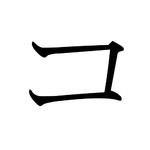transliteration ko hiragana origin 己 spelling kana 子供のコ(Kodomo no "ko") | translit. with dakuten go katakana origin 己 | |
 | ||
こ, in hiragana, or コ in katakana, is one of the Japanese kana, each of which represents one mora. Both represent [ko]. The shape of these kana comes from the kanji 己.
This character may be supplemented by a dakuten; it becomes ご in hiragana, ゴ in katakana, and go in Hepburn romanization. Also, the pronunciation is affected, transforming into [ɡo] in initial positions, and varying between [ŋo] and [ɣo] in the middle of words.
A handakuten (゜) does not occur with ko in normal Japanese text, but it may be used by linguists to indicate a nasal pronunciation [ŋo].
Other communicative representations
The Wabun code for こ or コ is ----.
References
Ko (kana) Wikipedia(Text) CC BY-SA
